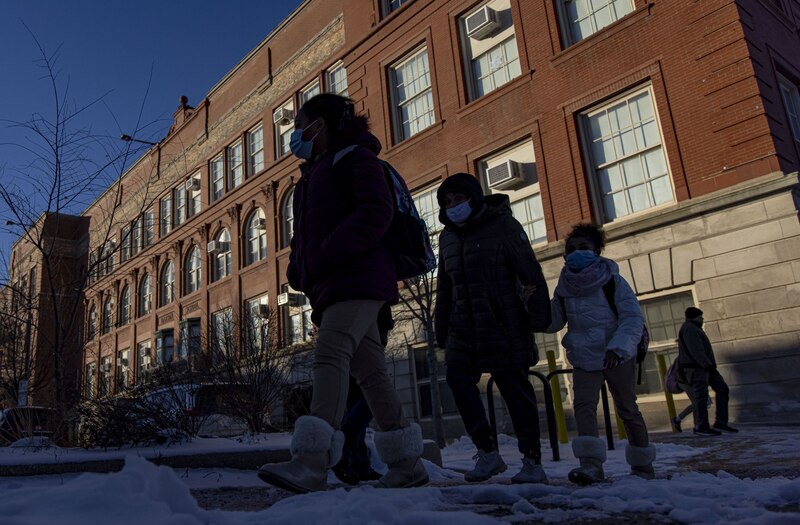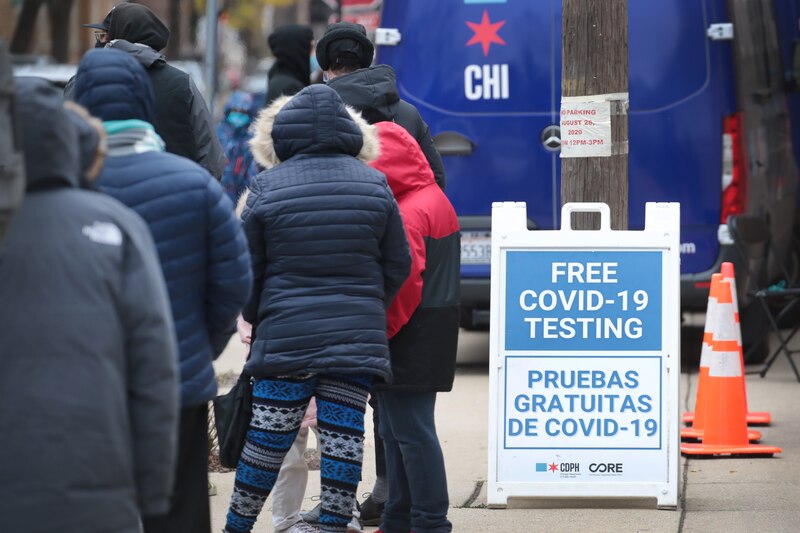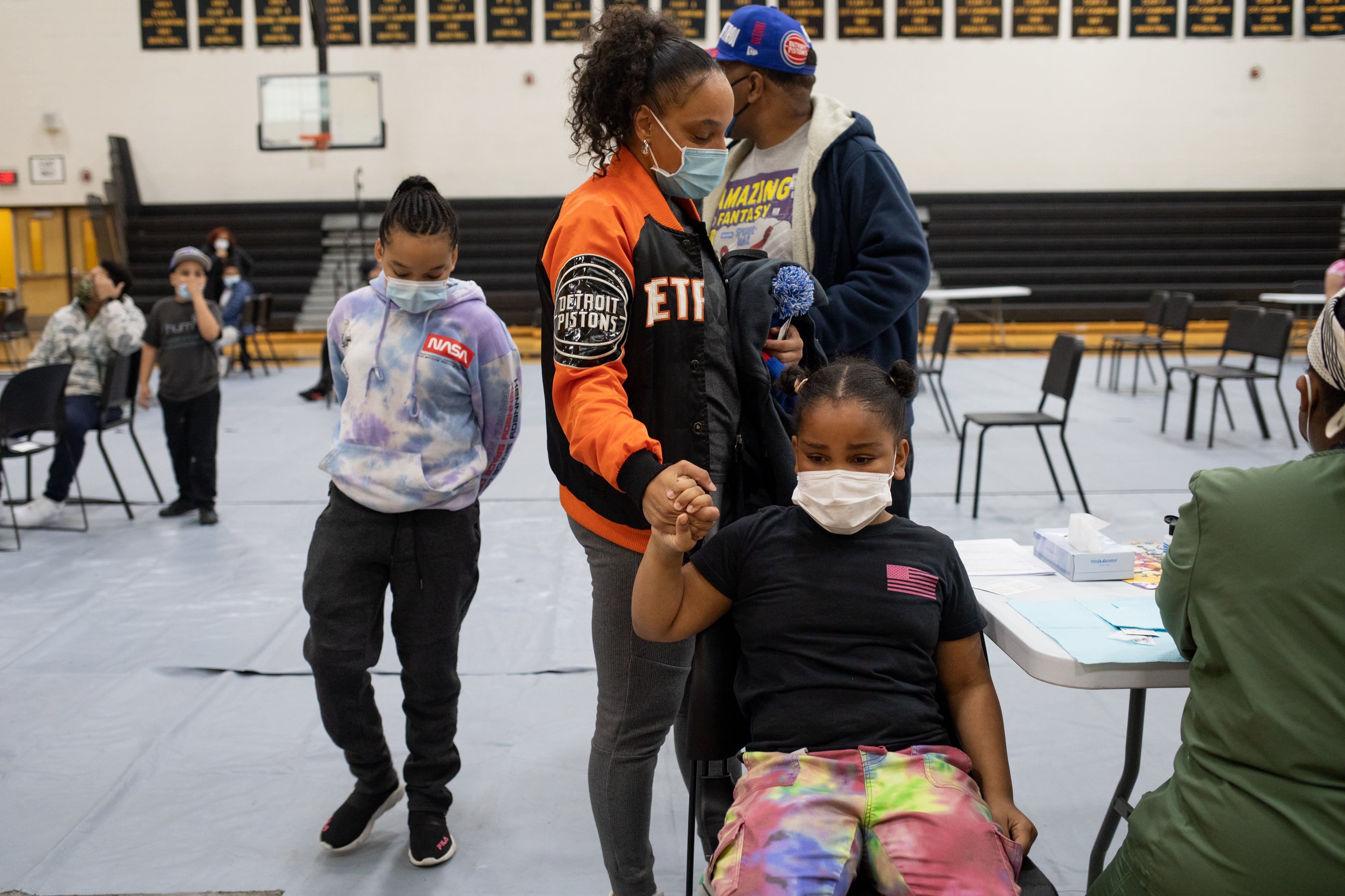At Manley Career Academy High School on Chicago’s West Side, only 10% of students are fully vaccinated against COVID-19. That’s a sharp contrast with Lane Tech High School on Chicago’s North Side where 83% of students have received both doses of the coronavirus vaccine.
Even at the district’s regional vaccination hubs – created to make COVID vaccines more accessible to students — rates swing widely from 56% at Theodore Roosevelt High School on the Northwest Side to 19.6% at Chicago Vocational Career Academy on the Far South Side
The school-based COVID vaccination data, which reflects fully vaccinated students through Dec. 1, was obtained by Chalkbeat through a public records request. It illustrates the vast disparities in vaccination rates within the city and touches on the heart of the debate that has abruptly shuttered Chicago schools this week — that safety measures look vastly different school to school.
Chalkbeat also obtained data through Dec. 10 showing wide variances among campuses for school-based COVID testing enrollment, which sits at 16% across city schools.
Here are several takeaways from Chalkbeat’s analysis of Chicago’s school-based vaccination and testing data:
- Majority Black high schools had an average vaccination rate of 28%, compared to majority Latino high schools, which averaged 57%.
- Opt-in rates for school-based testing, like vaccine rates, vary widely by school, with some South and West Side campuses having fewer than five students opting in.
- At more than 200 schools, the opt-in COVID testing rates fall short of the city’s 10% threshold goal. At 70 schools, 10 or fewer students are enrolled in the school-based testing program.
- Vaccination and opt-in rates don’t always correlate. Some schools with high vaccination rates have lower than average COVID opt-in rates for testing.
Low vaccination rates among Black and Latino teens, a surging COVID rate due to the omicron variant, and a botched testing regimen are all issues that have galvanized Chicago’s teachers union in the past week. The district’s opt-in testing approach, in particular, has been a key sticking point in an impasse that has shut down classes in the nation’s third largest school district for three days — and possibly for days to come.
The union has asked for a negative COVID PCR test for each student to reopen. Union leaders have also called on the district to automatically enroll students in school-based COVID testing programs, to set a metric for when to close schools in the event of a COVID outbreak, and to allow more teachers with medical conditions the accommodations to work remotely.
The teachers union has also asked for more transparency around opt-in testing and for vaccination rates to be made public.
Districtwide, about 51% of Chicago Public Schools’ 12- to 17-year-old students are fully vaccinated against COVID-19, according to figures released by CPS Tuesday. Across the city, 73% in that age group are fully vaccinated, but that does not break out teenagers in public schools versus private ones. The national average for 12- to 17-year-olds is 53%, latest figures show.
About 24% of 5- to 11-year-old students in CPS have received at least one dose, compared with 34% of children in that age group across the city, according to figures shared Tuesday. About 12% of 5- to-11-year-olds in the district were fully vaccinated, according to the Tribune.
However, the city and district averages don’t reflect the wide range of vaccination rates revealed by the data obtained by Chalkbeat, which shows that, at some schools, the vast majority of students remain unvaccinated.
Although the city has acknowledged that rates for both testing and COVID vaccinations are lower than they had hoped and pledged to do more, city health officials and schools chief Pedro Martinez have argued that closing school buildings would be a setback for efforts.
“If we go into a week and another week where we have kids out of school for long periods of time, I worry a lot about what happens next,” said Dr. Allison Arwady, the city’s public health commissioner, as the threat of a shutdown loomed.
Chicago Public Schools did not respond to questions regarding vaccination and opt-in testing rates across the district.

Vaccination rates lag even at some regional ‘hubs’
Chicago public health officials began 2022 touting progress in the city’s child COVID vaccination rate, after a worrying lag in uptake among 12- to 17-year-olds that persisted through most of the fall.
The role schools play in the vaccination strategy has been a key debate in the dispute between district officials and union leaders, with union leaders calling for more school-based sites. Chicago Public Schools offers four regional vaccination hubs with a regular rotating schedule of appointments, and a mobile van that travels to schools. Many schools have also organized single-day mass vaccination events. Those with events on their calendar next week were making pleas for families to still come.
The union has argued that a regular rotation of school-based vaccination sites would offer parents and families access at pickup and drop off — and that should be a priority. District leaders, meanwhile, have expressed frustration at the low uptake at some of its school-based events, saying this summer, low demand was preventing the district from opening more school-based vaccine centers across Chicago and running them for longer hours.
The district needs “the right messengers” to book those slots, officials said.
“We need teachers to tell their students to go get vaccinated. To tell their parents,” interim CEO Jose Torres said in July.
The school-based vaccination data show a wide variance among the four regional schools that consistently offered vaccines on a rotation each week.
Among the four sites — Theodore Roosevelt High School on the city’s Northwest Side, Richards High School in Back of the Yards, Michele Clark High School on the West Side, and Chicago Vocational on the Far South Side — only Roosevelt, where the student body is majority Latino, reported a rate higher than the 56% average for all high schools.
Richards came close, with 39% of students vaccinated, but only 19.6% of Chicago Vocational High School students were fully vaccinated, data shows.
Across all high schools, rates of vaccination vary widely, with schools in neighborhoods on the South Side averaging among the lowest vaccine uptake more than half a year after pediatric vaccines were made available for teenagers.
High schools with more than 50% Black students had an average vaccination rate of 28.09%. Those with fewer than 50% Black students were much higher at 57.62%, according to Chalkbeat’s analysis.
By contrast, high schools with more than 50% Latino students averaged 56.76% vaccinated. Those with less than 50% Latino student population averaged 37.49%, data shows.
The high schools with the highest vaccination rate in the city, Northside College Prep and Lane Tech High, both had an 83% vaccination rate, compared to an average rate of 46% as of Dec. 1, the cutoff date for the data provided through the records request. Both are selective enrollment, or test-in, high schools.
Board certified pediatrician and internal medicine specialist Dr. Beth Van Opstal says there is a need for consistent messaging about the benefits of COVID vaccines and wonders if a coordinated messaging campaign backed by both the union and the district would boost rates among children.
Van Opstal said she was pleased to see the health clinic at her school, National Teachers Academy, offer vaccinations to the students there. Parents could easily stop by with their children — and as quarantine notices began going out, having a vaccinated child meant fewer days at home (Chicago Public Schools requires unvaccinated children to quarantine, but vaccinated children are supposed to be allowed to continue classes).
Chalkbeat did not report rates among elementary students because the data cutoff was only weeks after the federal government approved vaccine use in children ages 5 to 11.
“It’s a clear message that CPS and CTU could have pushed more – if your kid is vaccinated, your kid can stay at school,” she said.
Van Opstal said she’d like to see a joint effort between the school district and teachers union to boost access to families and spread messaging that vaccinated individuals tend to see milder COVID symptoms.
Health officials have said that students are more likely to get vaccinated if their parents are vaccinated. Auburn Gresham, North Lawndale, Austin, Hyde Park, Avalon Park, Washington Heights, West Pullman, South Deering, Garfield Park, Galewood, and Grand Crossing all averaged a vaccination rate lower than 10% among schools there, records show. Those neighborhoods are also in zip codes with some of the lowest adult vaccination rates in the city.
By contrast, schools on the North Side and in and around the Loop had the highest vaccination averages. The high schools in Network 14, which covers the North and Northwest Side, together had the highest averages among high school networks at 60%.
By contrast, schools on the South Side such as Carver Military, Bronzeville HS, Corliss, and Chicago Vocational High School, averaged just under 30%.
University of Chicago medical ethicist Dr. Will Parker, who is an ICU physician, studied COVID vaccine access in Chicago during the first wave of release to adults over 65. His study documented rates of vaccine access and found differences by neighborhood.
In his initial study, vaccine supply was limited. That’s no longer the issue — Chicago has ample supplies of vaccine doses for children between 5 and 17, but some families may experience barriers to access, he said, such as not having a car to drive to the vaccination site or needing to work instead of accompanying a child to an appointment.
“We should be doing more to lower those barriers of access,” he said.
Opt-in rates for school-based COVID testing remain low
Since the outset, the district’s school-based COVID testing — a key component in its strategy for reopening schools safely — has been mired in problems.
It’s been hampered by a lack of communication, language barriers, poor promotion, a lack of testing supplies, and unstable rollout.
CPS, which contracted with Massachusetts-based vendor ThermoFisher to roll out a voluntary testing program that families had to “opt in” to, is far from the only district to have struggled. Nationally, school districts across the country have had to try and build testing programs and expertise, something city and state governments were struggling, and still struggle, to do.
Chicago’s program asked parents to give their consent online through a platform some families found cumbersome. ThermoFisher was supposed to set up testing at least once a week at every school where children would mostly use nasal swabs themselves under supervision.
After promising a testing program would be ready the first week of school, the district experienced multiple delays across several weeks setting up the program, with some schools saying that, even after the rollout was complete, testing vendors didn’t consistently show up. But the biggest challenge was that, three months into reopening schools, fewer than 10% of students had signed up for the district’s school-based COVID testing.
School-level data obtained by Chalkbeat show that, by mid-December, that rate had increased to 16% citywide but some schools still only had a handful of children signed up.
As of Dec. 10, nearly 300 schools — 58% of district-run schools — had hit the 10% threshold. More than 200 schools still had fewer than 10% of students and – even more concerning – about 70 schools had 10 or fewer students signed up. At more than 20 schools, fewer than five students had opted into testing at Little Village, North Lawndale, Englewood, and Austin schools, data shows.
Union leadership has called on the district to shift to opt-out testing, something city officials have rejected. The district previously stated that it was following guidance from the Centers for Disease and Control and Prevention, Illinois Department of Public Health, and Illinois State Board of Education, which “states that testing should not be conducted without the informed consent of a parent or guardian.
Mayor Lori Lightfoot on Wednesday said they would not conduct “a quasi-medical procedure on children without their parents’ knowledge or consent.”

Testing increase at one school required “all-hands-on-deck”
Still, some schools have managed to buck the low opt-in rate through persistent staff outreach.
One principal at a South Side elementary school, speaking on the condition of anonymity because she wasn’t authorized to speak on the topic, said that boosting her school’s rates required a parent-by-parent approach. “As families began to see test results come back, more signed up.”
At Woodlawn Community School on the city’s South Side, more than 89% of students have opted into the testing program — the highest rate across district schools. Marcia Olivier, a school clerk at Woodlawn Community School, noticed the opt-in link sent to parents early on didn’t yield much buy-in. She said she knew early on they needed to do more.
Olivier sent out the link herself, provided paper copies to teachers to be sent home with students, made calls, and met with parents to assist them with completing the online forms. When some parents expressed concern over the nasal swab tests, Olivier walked them through the testing logistics.
Other parents, she said, were wary of filling out their child’s information online.
With the help from teachers, it was an “all-hands-on-deck” situation to make sure they could get as many students signed up to protect students and staff, Olivier said.
Olivier is still working to hit 100% opt-in rates.
Amid a surge of cases, Olivier said her next goal is to employ the same strategies of speaking directly with parents to get 5- to 11-year-old students vaccinated.
“It’s hard work,” Olivier said, “but everyone has to pull together to get that buy-in.”






